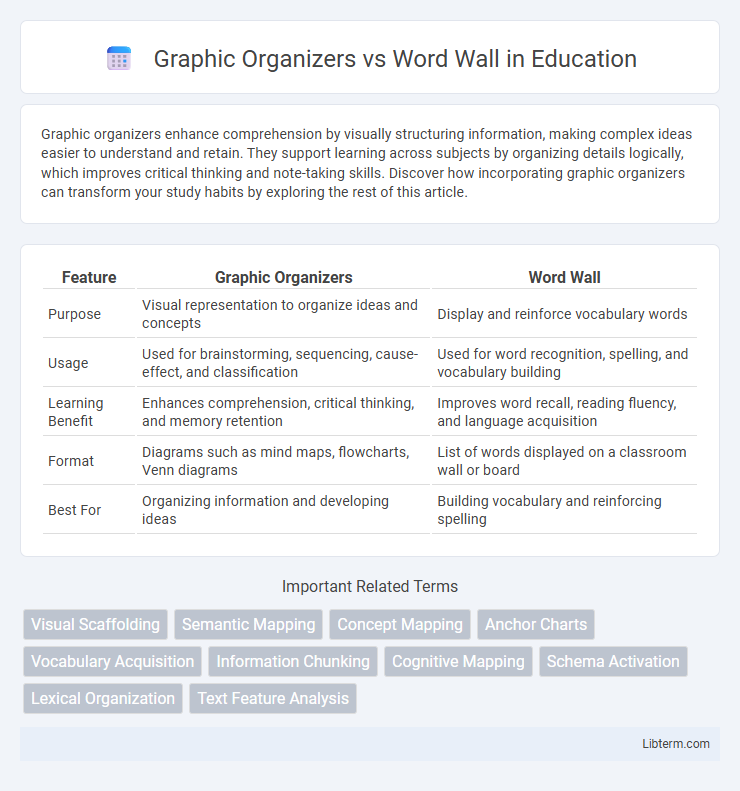Graphic organizers enhance comprehension by visually structuring information, making complex ideas easier to understand and retain. They support learning across subjects by organizing details logically, which improves critical thinking and note-taking skills. Discover how incorporating graphic organizers can transform your study habits by exploring the rest of this article.
Table of Comparison
| Feature | Graphic Organizers | Word Wall |
|---|---|---|
| Purpose | Visual representation to organize ideas and concepts | Display and reinforce vocabulary words |
| Usage | Used for brainstorming, sequencing, cause-effect, and classification | Used for word recognition, spelling, and vocabulary building |
| Learning Benefit | Enhances comprehension, critical thinking, and memory retention | Improves word recall, reading fluency, and language acquisition |
| Format | Diagrams such as mind maps, flowcharts, Venn diagrams | List of words displayed on a classroom wall or board |
| Best For | Organizing information and developing ideas | Building vocabulary and reinforcing spelling |
Introduction to Graphic Organizers and Word Walls
Graphic organizers visually structure information to enhance comprehension and retention by organizing ideas into categories such as charts, maps, and diagrams. Word walls display key vocabulary on classroom walls, supporting language development and word recognition through constant visual exposure. Both tools facilitate interactive learning, with graphic organizers focusing on content organization and word walls emphasizing vocabulary acquisition.
Defining Graphic Organizers
Graphic organizers are visual tools that structure information to enhance learning by illustrating relationships between concepts, ideas, and data. They include diagrams such as mind maps, flowcharts, and Venn diagrams, which support critical thinking and comprehension across various subjects. Word walls, in contrast, are displays of key vocabulary words designed to improve language acquisition and literacy skills by providing constant visual reinforcement.
Understanding Word Walls
Word walls are visual displays that organize vocabulary words alphabetically or thematically to enhance language acquisition and retention. They support students' understanding by providing constant, accessible references for spelling, pronunciation, and meaning, fostering independent word recognition and reinforcing language concepts. Unlike graphic organizers, which structure information hierarchically or relationally, word walls serve as dynamic, interactive tools that promote ongoing vocabulary development in diverse learning environments.
Key Differences Between Graphic Organizers and Word Walls
Graphic organizers visually map out information, allowing students to organize ideas, relationships, and concepts through charts or diagrams, which enhances comprehension and retention. Word walls display key vocabulary words on classroom walls, promoting word recognition, spelling, and language development through constant exposure and review. The key difference lies in graphic organizers facilitating active structuring of knowledge, while word walls focus on passive reinforcement of vocabulary.
Benefits of Using Graphic Organizers
Graphic organizers enhance comprehension by visually structuring information, making it easier for students to identify relationships and categorize key concepts. They support diverse learning styles by integrating diagrams, charts, and maps, which aid memory retention and critical thinking. Using graphic organizers fosters active engagement and improves problem-solving skills compared to static word walls.
Advantages of Implementing Word Walls
Word walls enhance vocabulary retention by providing continuous visual reinforcement of key terms, enabling quick reference and promoting active language acquisition. They support diverse learning styles by integrating visual elements with phonetic cues, which improves spelling and word recognition skills. Implementing word walls fosters collaborative learning and student engagement through interactive activities that encourage regular practice and review.
Classroom Applications: Graphic Organizers vs Word Walls
Graphic organizers enhance classroom learning by visually structuring information, aiding students in organizing thoughts, understanding relationships, and improving comprehension across subjects like reading, science, and math. Word walls support vocabulary development by displaying key terms prominently, encouraging word recognition, spelling, and language retention, particularly in early literacy and English language learner classrooms. Combining graphic organizers with word walls creates a dynamic learning environment where conceptual understanding and language skills reinforce each other for diverse student needs.
Choosing the Right Tool for Your Teaching Goals
Selecting between graphic organizers and word walls depends on specific teaching goals such as enhancing vocabulary retention or organizing complex information visually. Graphic organizers excel in helping students structure ideas, identify relationships, and improve critical thinking skills through diagrams like mind maps and flowcharts. Word walls are effective for building sight word recognition and vocabulary development, especially in language acquisition and early literacy instruction.
Integrating Both Methods for Maximum Impact
Integrating graphic organizers with word walls enhances vocabulary retention and comprehension by combining visual mapping with constant exposure to key terms. Graphic organizers stimulate critical thinking and help students organize information structurally, while word walls provide a dynamic reference that reinforces spelling and meaning through repeated interaction. Utilizing both methods creates a multisensory learning environment that supports diverse learning styles and maximizes cognitive engagement.
Conclusion: Enhancing Learning with Visual Tools
Graphic organizers and word walls both significantly enhance learning by leveraging visual structures to improve information retention and comprehension. Graphic organizers facilitate the organization of complex ideas through diagrams, aiding critical thinking and concept mapping, while word walls support vocabulary development and spelling through consistent visual reinforcement. Combining these tools creates a dynamic learning environment that caters to diverse cognitive processes, promoting deeper understanding and academic success.
Graphic Organizers Infographic

 libterm.com
libterm.com